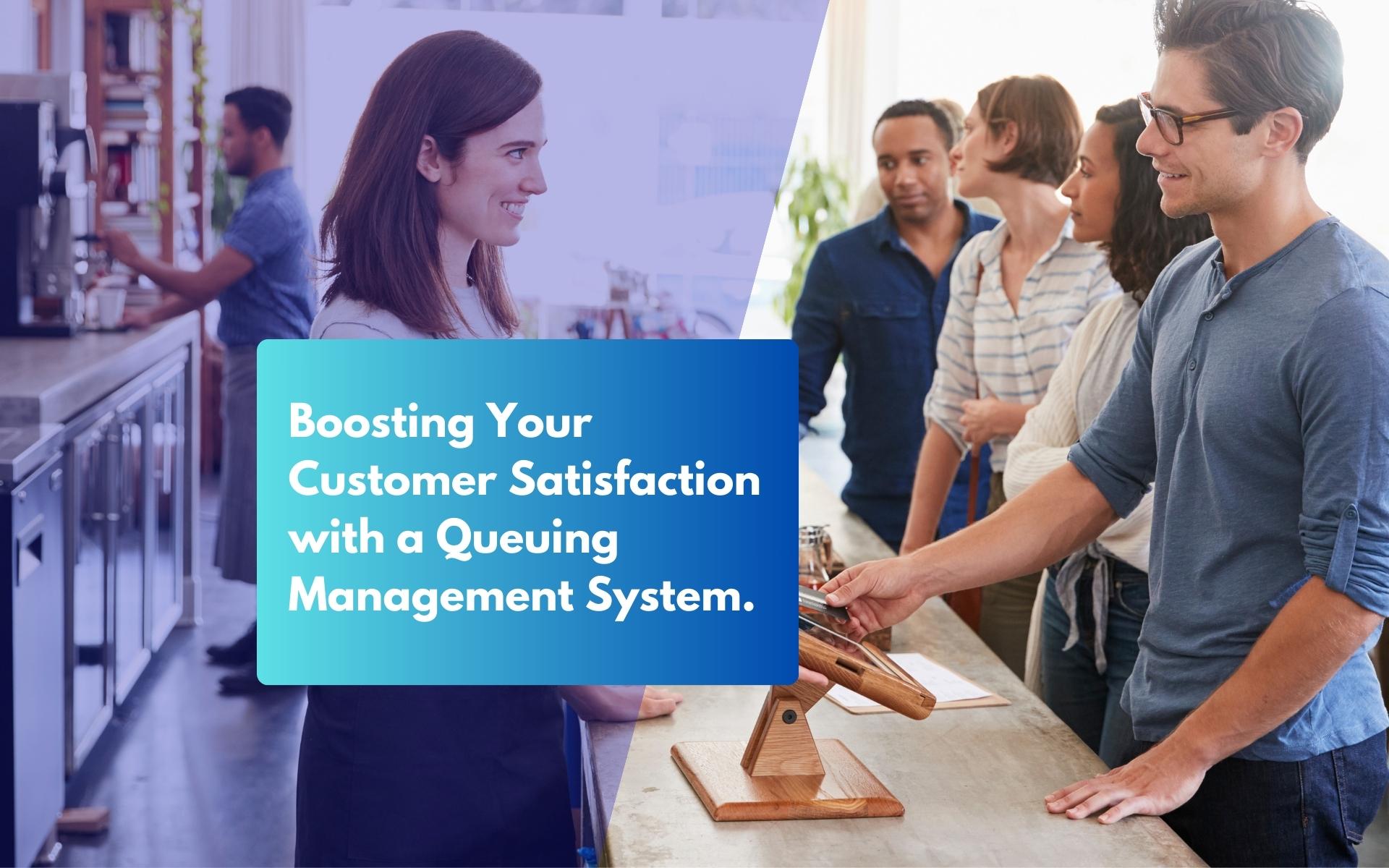Optimizing Your Customer Flow with a Queuing Management System In the relentless world of business, the efficient management of customer flow has …
Optimizing Your Customer Flow with a Queuing Management System

In the relentless world of business, the efficient management of customer flow has emerged as a pivotal factor in achieving success. Every interaction between your customers and your business plays a crucial role in shaping their experience and their perception of your brand. One transformative tool that can take your customer flow management to the next level is a Queuing Management System (QMS). In this article, we’ll explore the significance of customer flow optimization and delve into the key benefits of implementing a QMS, highlighting aspects like customization, user experience, data-driven decision-making, staff productivity, and competitive advantage.
The Importance of Customer Flow Optimization
Efficiently managing the flow of customers through your business is more than just a matter of convenience; it’s a strategic imperative. Here’s why optimizing customer flow is of paramount importance:
1. Customer Satisfaction
A seamless and hassle-free customer journey enhances satisfaction and builds customer loyalty. Customer satisfaction is a fundamental goal for businesses across all industries. It refers to the level of contentment or happiness a customer experiences when interacting with a business or using its products and services. In the context of a QMS, customer satisfaction is closely tied to the overall experience a customer has while waiting in line, receiving service, and interacting with your business.

How a QMS Impacts Customer Satisfaction:
A. Reduced Wait Times
One of the most direct ways a QMS improves customer satisfaction is by reducing wait times. Long, unpredictable wait times can lead to frustration and dissatisfaction. With efficient queuing management, customers spend less time waiting and more time engaging with your products or services.
B. Transparency and Control
A QMS can provide customers with real-time updates on their queue status, estimated wait times, and their position in the queue. This transparency gives customers a sense of control over their wait, reducing anxiety and frustration.
C. Appointment Scheduling
Many QMS solutions offer appointment scheduling features. Allowing customers to schedule appointments in advance not only minimizes wait times but also ensures that they receive prompt service when it’s most convenient for them, contributing to higher satisfaction.
D. Improved Service Delivery
QMS software helps ensure that the right staff members are available to serve customers at the right times. When customers receive timely and efficient service, it enhances their overall satisfaction.
E. Feedback Mechanisms
Some QMS solutions include feedback mechanisms that allow customers to provide comments or rate their experiences. This feedback can be invaluable in identifying areas for improvement and ensuring that customer concerns are addressed promptly.
F. Compliance with Social Distancing
In today’s environment, where social distancing is essential, a QMS with virtual queuing capabilities helps businesses comply with these guidelines. This demonstrates a commitment to customer safety and contributes to their peace of mind.
G. Repeat Business and Loyalty
Satisfied customers are more likely to return to your business and become loyal patrons. They are also more likely to recommend your business to others, contributing to organic growth through word-of-mouth referrals.

2. Operational Efficiency
Optimized customer flow translates into efficient resource allocation, reducing idle time and operational costs. Operational efficiency is a critical aspect of business management that focuses on optimizing processes and resource allocation to achieve maximum productivity with minimal waste. In the context of optimizing customer flow with a Queuing Management System (QMS), operational efficiency plays a pivotal role in ensuring that your business runs smoothly and effectively. Here’s a more in-depth explanation of operational efficiency and how it relates to QMS implementation:
Key Elements of Operational Efficiency:
A. Resource Allocation
Operational efficiency involves allocating resources such as staff, time, and equipment in a way that maximizes their utilization. With a QMS, you can allocate staff to queues based on real-time data, ensuring that you have the right number of employees serving customers at any given time.
B. Process Optimization
Businesses often have various processes in place to serve customers, from check-in procedures to service delivery. Operational efficiency requires streamlining and optimizing these processes to reduce bottlenecks and minimize delays. A QMS can help identify and address process inefficiencies by providing data on queue lengths, wait times, and service times.
C. Cost Management
Efficiency includes cost-effective resource management. By optimizing staff scheduling and reducing idle time, a QMS can help control labor costs. Additionally, shorter customer wait times can lead to lower operational costs, as customers spend less time using your resources.
D. Data-Driven Decisions
Operational efficiency relies on data-driven decision-making. A QMS collects and analyzes data on customer flow, queue status, and service times. This data allows you to make informed decisions about resource allocation, staffing levels, and process improvements.
How a QMS Enhances Operational Efficiency:
A. Resource Optimization
A QMS provides real-time information on queue status, enabling you to allocate staff resources where they are needed most. This ensures that you have the right number of employees available to serve customers efficiently, reducing both overstaffing and understaffing issues.
B. Queue Management
By efficiently managing customer queues, a QMS helps reduce congestion and wait times. Shorter queues mean that customers spend less time waiting and more time receiving service, leading to improved resource utilization and operational efficiency.
C. Process Streamlining
The data collected by a QMS allows you to identify bottlenecks and areas where processes can be streamlined. This streamlining minimizes customer wait times and optimizes the use of your facilities and staff.
D. Customer Flow Analytics
QMS solutions offer analytics and reporting features that provide insights into customer flow patterns. This information helps you make proactive decisions to allocate resources effectively during peak hours or address issues that may arise during slower times.
E. Cost Reduction
By optimizing staffing levels and reducing idle time, a QMS can help control labor costs. Additionally, shorter customer wait times can lead to lower operational costs, as customers spend less time using your resources.

3. Revenue Growth
Satisfied customers are more likely to return and make additional purchases, contributing to revenue growth. Revenue growth is a key financial metric that measures the increase in a company’s total income or sales over a specific period. It is a crucial indicator of a business’s financial health and sustainability. When it comes to optimizing customer flow with a Queuing Management System (QMS), revenue growth can be influenced in various ways:
A. Increased Customer Throughput
A well-implemented QMS can help your business serve more customers efficiently. By reducing wait times and streamlining processes, you can accommodate more customers within the same operating hours. This increase in customer throughput directly impacts revenue, as more transactions or services are completed each day.
B. Enhanced Customer Satisfaction
Higher customer satisfaction, often facilitated by shorter wait times and improved service experiences, can lead to increased customer loyalty. Satisfied customers are more likely to return for repeat business and may even become advocates who refer others to your establishment. This repeat business and word-of-mouth referrals contribute directly to revenue growth.
C. Additional Sales Opportunities
Reduced customer wait times and more efficient operations provide additional opportunities to upsell or cross-sell products and services. For example, in a retail setting, customers who have a quick and positive checkout experience may be more inclined to make impulse purchases or explore other products in the store, boosting sales.
D. Appointment Scheduling
Many QMS solutions offer appointment scheduling capabilities, particularly useful in industries like healthcare and professional services. Appointment scheduling not only ensures that customers receive prompt attention but also allows you to plan for a steady stream of appointments throughout the day, optimizing staff utilization and revenue generation.
E. Improved Staff Productivity
With a QMS in place, staff can focus more on serving customers and less on managing queues manually. This increased productivity can result in faster service, more efficient use of labor resources, and the ability to serve a larger number of customers during peak hours.
F. Data-Driven Decision-Making
QMS software provides valuable data and insights into customer flow and operational efficiency. By analyzing this data, you can make informed decisions about staffing levels, resource allocation, and process improvements, all of which can contribute to revenue growth by ensuring that you’re optimizing your operations.
G. Competitive Advantage
Businesses that implement a QMS gain a competitive advantage in the marketplace. Customers are more likely to choose a business that offers a streamlined and efficient queuing experience over one with long and disorganized queues. This advantage can translate into increased market share and, consequently, revenue growth.
H. Cost Control
Operational efficiency, driven by a QMS, can help control costs by reducing overstaffing during slow periods and minimizing idle time. The cost savings realized from efficient resource allocation can directly contribute to increased profitability and revenue growth.

4. Competitive Edge
Businesses that offer streamlined queuing experiences stand out in a crowded market, attracting more customers. A competitive edge, often referred to as a competitive advantage, is the unique position or set of strengths that allows a business to outperform its competitors in the marketplace. It’s the factor that sets your business apart and gives you an edge over others in your industry. When it comes to optimizing customer flow with a Queuing Management System (QMS), gaining a competitive edge is a significant benefit. Here’s a deeper look at how a QMS can contribute to a competitive edge:
A. Improved Customer Experience
A key component of a competitive edge is providing a superior customer experience. A well-implemented QMS enhances the customer journey by reducing wait times, minimizing frustration, and ensuring a smoother and more enjoyable experience. When customers have a positive experience with your business, they are more likely to choose you over competitors.
B. Shorter Wait Times
One of the primary ways a QMS contributes to a competitive edge is by reducing customer wait times. Long queues and extended wait times can deter potential customers and lead to dissatisfaction among existing ones. A QMS efficiently manages queues, ensuring that customers spend less time waiting and more time engaging with your products or services.
C. Transparency and Control
A QMS provides real-time updates to customers, informing them about their queue status, estimated wait times, and their position in line. This transparency gives customers a sense of control over their wait, reducing anxiety and frustration. It also fosters trust in your business, as customers appreciate being informed and empowered during their visit.
D. Social Distancing Compliance
In today’s world, adherence to social distancing guidelines is crucial for public health and safety. A QMS with virtual queuing capabilities helps businesses comply with these guidelines by reducing the need for physical lines and overcrowded waiting areas. Demonstrating a commitment to customer safety can be a valuable competitive advantage.
E. Operational Efficiency
A QMS enhances operational efficiency by optimizing resource allocation, staff scheduling, and process management. Efficient operations lead to cost savings, which can be reinvested in other areas of your business or used to offer competitive pricing.
F. Competitive Pricing
Reduced operational costs, as a result of an efficient QMS, can enable your business to offer competitive pricing. Lower prices or value-added services can attract cost-conscious customers and give you an edge in the market.
G. Customer Loyalty and Word-of-Mouth Marketing
Satisfied customers are more likely to become loyal patrons and recommend your business to others. Loyal customers not only provide a consistent source of revenue but also serve as advocates who promote your business through word-of-mouth marketing.
H. Differentiation in Marketing
Your use of a QMS can be a unique selling point in your marketing efforts. Highlighting the fact that you offer a streamlined and hassle-free queuing experience can make your business more attractive to potential customers.
Benefits of Implementing a QMS
A Queuing Management System offers a multitude of advantages that can revolutionize your customer flow management. Let’s explore these benefits in depth:
1. Customization and Branding
Tailoring the QMS to align with your business’s unique needs and branding is a key advantage. This level of customization ensures that the system seamlessly integrates into your operations while reflecting your brand identity.
2. User Experience
A user-friendly interface is pivotal, not only for customers but also for your staff. A well-designed QMS minimizes confusion and frustration, making it easy for everyone to navigate and utilize effectively.
3. Data-Driven Decision-Making
The heart of a QMS lies in its ability to gather data and provide valuable insights. Through data analytics and reporting features, you can make informed decisions about resource allocation, queue management, and overall customer flow optimization.
4. Staff Productivity
Efficient staff scheduling and resource allocation can lead to heightened staff morale and productivity. When employees see their time being used efficiently, they are more motivated to deliver excellent service, positively impacting the overall customer experience.
5. Competitive Advantage
Implementing a QMS gives your business a distinct competitive edge. Customers are naturally drawn to businesses that offer a streamlined and convenient queuing experience, setting you apart from competitors who may still rely on outdated methods.
Conclusion
In conclusion, optimizing customer flow is not just a business strategy; it’s a commitment to providing a superior customer experience. A Queuing Management System empowers your business to achieve this commitment by offering customization, enhancing user experiences, facilitating data-driven decision-making, boosting staff productivity, and granting you a competitive advantage.
By embracing a QMS and aligning it with your unique business goals, you’re not just managing queues; you’re unlocking the potential for higher customer satisfaction, increased operational efficiency, and sustainable revenue growth. In a world where customer expectations continue to rise, a QMS is your key to staying ahead and thriving in today’s competitive landscape.
Related Articles
Queuing Management Systems – The Key to Improving Your Business’ Bottom Line In the fast-paced world of business, time is money. Every …
Boosting Your Customer Satisfaction with a Queuing Management System. In today’s fast-paced world, customers expect not only quality products and services but …


